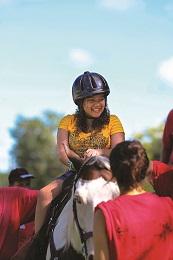

People with disabilities enjoy athletic activities as much as anyone else, and they make plenty of decisions that affect a city’s economic landscape, such as traveling into town for sports events, staying in hotels, eating in restaurants and purchasing souvenirs. Their choice to participate in an event carries the potential to become sources of increased registration both now and in the future, particularly if the athlete feels good enough about the event to return next time with friends and/or family members who also may or may not have disabilities.
Many times, people do not attend athletic events because they do not feel that the program is meant for them. It may not be a conscious decision to exclude people, but this often happens because we have not been proactive in including everyone. According to the US Census Bureau, about 56.7 million people — 19 percent of the population — had a disability in 2010, with many, particularly older people, reporting the disability was severe. According to the National Organization on Disability, people with disabilities have a combined income of more than $1 trillion with $220 billion in discretionary income. Overlooking this group can have serious ramifications to the event’s bottom line, and can mean excluding an essential part of the community.
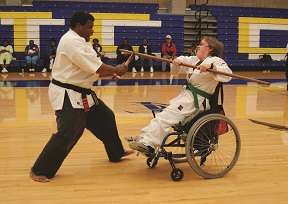 Unfortunately, many people with disabilities are still marginalized. This is because people are uncomfortable with the idea of disabilities. As children, they were taught not to stare at those who were different; as adults, they sometimes look away from, or ignore, people in wheelchairs, people who are amputees, people who are developmentally disabled or people who have just about any other type of challenge. Something they may not realize is that it’s actually much more polite, friendly and welcoming to make eye contact, smile and otherwise reach out.
Unfortunately, many people with disabilities are still marginalized. This is because people are uncomfortable with the idea of disabilities. As children, they were taught not to stare at those who were different; as adults, they sometimes look away from, or ignore, people in wheelchairs, people who are amputees, people who are developmentally disabled or people who have just about any other type of challenge. Something they may not realize is that it’s actually much more polite, friendly and welcoming to make eye contact, smile and otherwise reach out.
Without adults’ intervention, children naturally do this – they walk right up to people (regardless of whether or not they have disabilities), ask questions and engage them. As kids, we already have all those skills – as adults, we just need to tap back into them. Once we do, we find out the people we’ve been avoiding have stories and interests just like everyone else. They’re no longer so intimidating.
Bringing people with disabilities into athletic events means taking steps to show people that you are interested in accommodating them. Below is a list that is meant to provide suggestions as to how to get started doing that. It is by no means comprehensive.
- Make sure people with disabilities know that they are welcome. Your marketing pieces need to show that people with disabilities will receive the accommodations that will make the event or program easy for them to attend. This should be more than simply having a box to check that states “Click here if you need special accommodations.” Including photos in your marketing pieces that depict persons with disabilities participating in sporting events is one way to help people feel included – and to give them the heads-up that you are ready and willing to host all participants.
- Provide information about the accessibility of the facility where your program will be held. Include information about the building, such as location of curb cuts, roll-in shower and pool lift availability in advance in your marketing materials and have appropriate, easy to read, signage on-site.
- Provide sign language interpreters. You may not have any hearing-impaired people attending your event the first time you provide this service, but word of mouth travels. Once people with hearing impairments find out that you have this service, they will start to attend your programs. This goes for all types of disabilities, too. Communities of people with disabilities are incredibly well-connected and they will share information about accessible events that were fun for them.
-
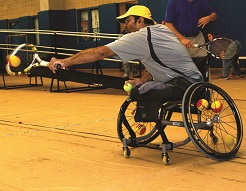 Make sure that your receptions, computer stations and information booths have tables that are low enough to be accessed by someone who uses a wheelchair.
Make sure that your receptions, computer stations and information booths have tables that are low enough to be accessed by someone who uses a wheelchair. - Make the information on your website usable by people with vision impairments. Even PDF files can be read using assistive technology if they are formatted correctly.
- Recruit volunteers who would be willing to assist a person with a disability with their needs. (More about this in a minute). Once you have committed volunteers, market that you have this service available upon request. The person with a disability and the volunteer can determine together what those needs may be. If you need to create a ‘think tank’ by contacting some local groups that work with individuals with disabilities, you’ll get even more ideas for how to make things accessible.
- Think outside your sports venues. Make sure that your aisles in exhibit halls, receptions, banquets, dinners, silent auctions and rooms for ancillary events are wide enough for a wheelchair to navigate. It is frustrating for people to want to see an event, but they are unable to get to it. A silent auction that can only be reached via stairs will limit the number of people who can bid on items. Remember too, events that have athletes with disabilities may have spectators with disabilities as well. Make sure your seating, concessions, parking, rest rooms and other accommodations are suitable.
-
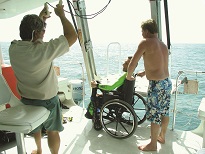 If you are holding functions off-site, make sure that the transportation arranged is accessible. The same considerations should be given to these special events as you give to your general program.
If you are holding functions off-site, make sure that the transportation arranged is accessible. The same considerations should be given to these special events as you give to your general program. - Avoid using outdated terms like “handicapped” or “disabled” and instead use “People First” language, such as “person with a disability” or “athlete with a disability.” This puts the focus on the person rather than on their disability.
- Ask the person with the disability how you can help; don’t make assumptions. Most people are very independent and can advise you on how or if they need assistance. Sometimes, that can intimidate volunteers or staff members; they’re just not sure how to act around a person who has a disability. They don’t know whether to offer to help – for example, does someone want their wheelchair pushed? Does someone with a visual impairment need to be led to a restroom? In all cases, we encourage people to reach out and offer help. If someone doesn’t need help, they’ll say so – but even so, they’ll be grateful for the gesture.
While some sports events will call for special training of volunteers and safety personnel (certain water sports and snow sports come to mind, although certainly there are more), others may simply require an overview of what will be needed and how to help. Not every volunteer will require first aid training or a comprehensive understanding of the athlete’s diagnosis in order to be of assistance with the event.
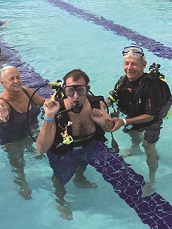 At the same time, something to let people know is that not all disabilities are the same. For example, an event may host a number of children with developmental disabilities, and each will be different in terms of their skills and challenges. You may have several adults with MS, each with a specific set of needs. As always, it is person-specific.
At the same time, something to let people know is that not all disabilities are the same. For example, an event may host a number of children with developmental disabilities, and each will be different in terms of their skills and challenges. You may have several adults with MS, each with a specific set of needs. As always, it is person-specific.
We started out this article with the idea that making the effort to recruit athletes with disabilities is a useful way to boost revenue. In reality, though, it goes much deeper than that. When you set up an event and make it accessible, something great happens. Not only does that event become easier for a disabled athlete to navigate, it becomes easier for everyone. From the website design to the layout of the event to the outgoing, willing personalities of the volunteers, it becomes a warm and welcoming place. It also makes athletes – again, with and without disabilities – tell their friends and family members about it. There’s no stronger reference – and no greater recommendation – than that.

